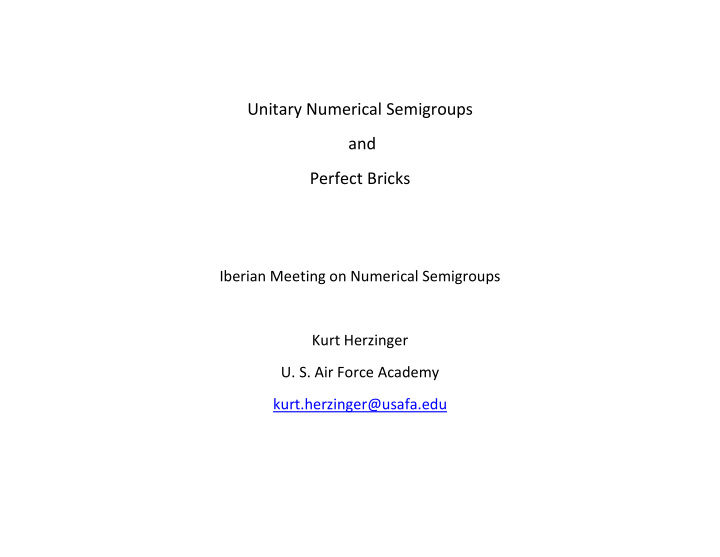



Unitary Numerical Semigroups and Perfect Bricks Iberian Meeting on Numerical Semigroups Kurt Herzinger U. S. Air Force Academy kurt.herzinger@usafa.edu
Notation = a numerical semigroup the multiplicity of = the smallest element of the Frobenius number of the holes of = = a non-principal relative ideal of = the number of elements in the minimal generating set of = the dual of in = ideal sum of and =
The following inequality is always true: . Question: Under what conditions is this equation true? Definition: If is a numerical semigroup and is a relative ideal of such that and and , then we say is an brick . Definition: If is an brick such that , then we say is an perfect brick .
Original Motivation The original motivation for examining the inequality comes from the study of torsion in tensor products of modules. Let be a one-dimensional local Noetherian domain with quotient field Let be a non- principal fractional ideal of and let . If , then the tensor product has non-zero torsion. If , then other techniques must be employed to investigate torsion in .
The natural relationship between the inequality and where , means that the latter inequality can reveal information about torsion in the tensor product of an ideal with its inverse. For more details on this investigation see: M. Auslander, Modules over unramified regular local rings , (1961) P. Constapel, Vanishing of Tor and torsion in tensor products , (1996) C. Huneke and R. Wiegand, Tensor products of modules and the rigidity of Tor, (1994) C. Huneke and R. Wiegand, Tensor products of modules, rigidity and local cohomology, (1997)
Partial Results (1996) If is a numerical semigroup such that and is a non-principal relative ideal of , then . (2002) If is a numerical semigroup such that and is a non-principal relative ideal of , then . (1997) If is a numerical semigroup such that and is a relative ideal of such that then . (1999) If is a numerical semigroup such that and is a non-principal relative ideal of then .
The First Bricks P. Constapel (1994) This is a perfect brick. Herzinger (1996) This is a brick (not perfect). P. Garcia-Sanchez and I. Garcia-Garcia (2001) This is a brick (not perfect and not symmetric).
2005 – work with Stephen Wilson, Nandor Sieban, and Jeff Rushall (Northern Arizona University). A systematic computer search revealed thousands of bricks. A subset of these bricks showed similarities that motivated the following definitions: Definition: Let be numerical semigroup of embedding dimension 4. (i) We say is balanced provided . If is balanced we define the common sum of to be . (ii) If is balanced we define the common quotient of to be . (iii) If is balanced and , then we say is unitary .
Examples is unitary is balanced but not unitary S is not balanced Note: All three of these numerical semigroups form bricks with an appropriate relative ideal . However, only the first one is perfect.
Theorem (2005 – Herzinger, Wilson, Sieben, Rushall) If is a unitary numerical semigroup and and , then is a perfect brick. This proves the existence of an infinite family of perfect bricks. How does this relate back to torsion in tensor products? In the process of proving the above theorem, we also proved that unitary numerical semigroups are symmetric. Now, a result by C. Huneke and R. Wiegand states If and is a one-dimensional, local, Gorenstein domain, then has non-zero torsion. Since unitary numerical semigroups are symmetric, we conclude that the tensor product corresponding to the relative ideals and all have non-zero torsion.
We conjectured that the converse of our theorem was also true. That is, every perfect brick comes from a unitary numerical semigroup. This was proved in 2007. Theorem (2007 – Holcomb, Herzinger) If is a perfect brick, then is a unitary numerical semigroup. The investigation of unitary numerical semigroups and perfect bricks created several questions that are unanswered.
Open Questions 1. Several examples of bricks of higher dimensions have been discovered: - a perfect brick - a perfect brick - a perfect brick Are there notions of “balanced” and “unitary” that apply to these higher dimensional bricks? Are these notions unique to bricks or are they just a special case of a more general concept yet to be discovered? Are there other infinite families of bricks that can be classified using similar notions?
2. In every example of a brick, that has been discovered, the ideal is reflexive. That is . In the case of perfect bricks this is clear, but it is even true when is not symmetric. Is this always true? 3. Are there any bricks with multiplicity 9? I have never found one. 4. Are there any bricks with ? I have never found one and I have not been able to prove that none exist. 5. Let and be non-principal relative ideals of a numerical semigroup such that . Under what conditions is it true that ? I have been able to prove that if and , then . In other words, this equality of relative ideals holds for bricks. I also have some examples of non-bricks where this holds.
The U. S. Air Force Academy
Recommend
More recommend